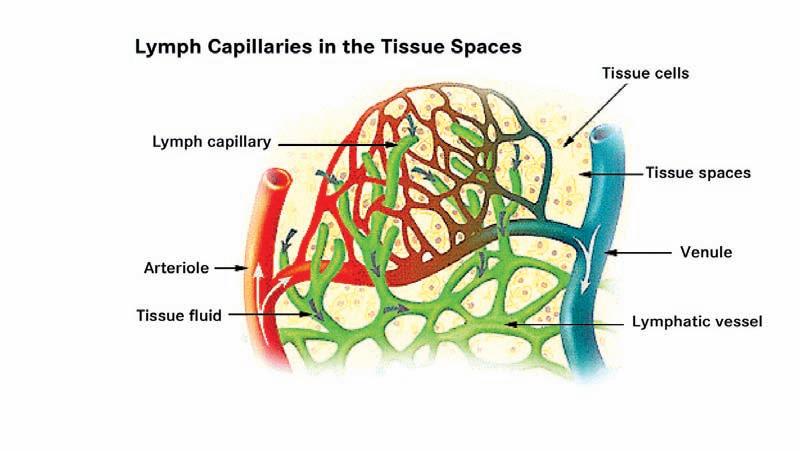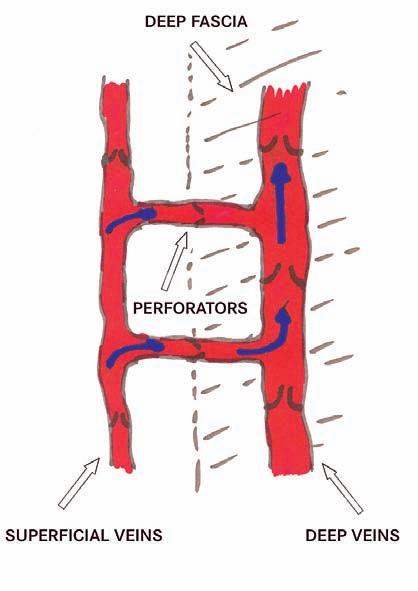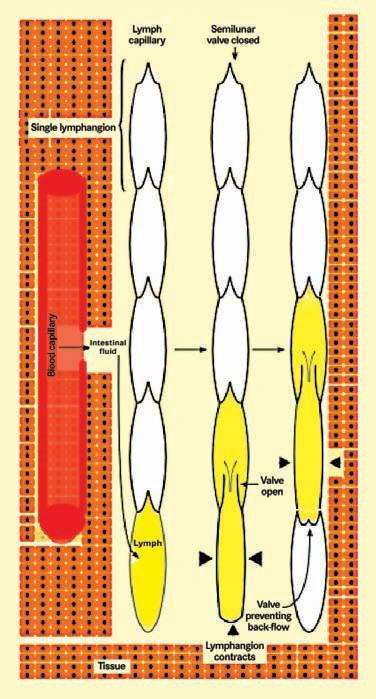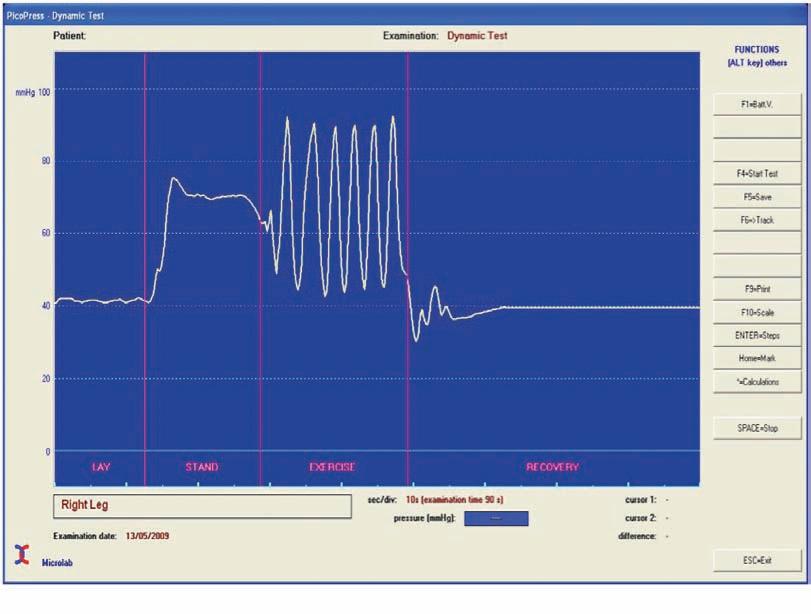The Science of Compression
By David KeastWeknow that compression therapy works to reduce and control edema in extremities but how does it work? Understanding the science of compression begins by examining how fluid moves between the blood vessels, the lymphatics and the tissue space. This movement of water, proteins, nutrients and waste products is critical to tissue survival. This is an integrated system and the arteries, veins, capillary bed and lymphatics cannot be considered in isolation.
Forces moving tissue fluid
Fluid only moves if it is pushed or pulled. The force pushing fluid is called hydrostatic pressure. We know that the deeper we go in a swimming pool the greater the force of the water above us. Similarly the force of gravity on the column of fluid in the blood vessels when a person is standing or the leg is dependent exerts a hydrostatic force on the fluid, the capillary hydrostatic pressure. Also if more fluid is forced into a confined space there will be increased hydrostatic pressure within that space. Thus as fluid accumulates in the interstitial space (the fluid in the spaces between the cells in the tissue), the interstitial fluid hydrostatic pressure increases. Water is also pulled between the capillaries and the interstitial space. The capillary walls are semi-permeable membranes allowing small molecules such as water to pass through but restricting the


movement of larger molecules such as proteins. Water moves across the membrane pulled in the direction of the higher concentration of proteins. This force is called the colloid oncotic pressure. The plasma proteins exert a plasma colloid oncotic pressure pulling water into the capillaries while the proteins and macromolecules in the interstitial space exert a tissue oncotic pressure pulling water into the issue space. These forces pushing and pulling fluid between the capillaries and the tissue spaces are sometimes called Starling Forces, named after a British physiologist who described the mechanisms of body fluid shifts. The other key component of tissue fluid handling is the lymphatics. Figure 1 shows the relationship between the capillary bed and the lymphatics. The lymphatic capillaries have a unique structure where the cells making up the wall of the lymphatic capillaries are tethered to the extracellular matrix. As the tissue hydrostatic pressure increases, this tethering causes portals to open into the lymphatics allowing the passage of water, proteins, macromolecules and cellular debris into the lymphatic capillaries.
David H. Keast MD FCFP is the Medical Director of the Chronic Wound Management Clinic at St. Joseph’s Parkwood Hospital in London, Ontario. He is Clinical Adjunct Professor of Family Medicine, Schulich School of Medicine and Dentistry, Western University (London) and Centre Director, Aging Rehabilitation and Geriatric Care Research Centre, Lawson Health Research Institute. He is Co-director of the Canadian Lymphedema Framework.
In his original work over 100 years ago Starling described an equilibrium in which there was net filtration of water out of the arterial side of the capillary bed and net re-absorption of fluid on the venous side as a result of the balance between capillary and tissue hydrostatic pressures as well as plasma and tissue colloid oncotic pressures. Based on calculations it was postulated that approximately 80–90% percent of interstitial fluid was reabsorbed by the venous side of the capillary bed and 10–20% was handled by the lymphatics. Newer research has shown, however, that in the extremities capillary hydrostatic pressure is never less than the tissue hydrostatic pressure and

that under normal circumstances there is no net re-absorption of fluid into the capillary bed. To further complicate the equation, the movement of proteins and other larger molecules across the semi-permeable membrane of the capillary walls is much more dynamic than previously thought. Newer models of tissue fluid balance suggest that in fact 100% of tissue fluid is handled by the lymphatics.1 In other words there is a net filtration of fluid out of the capillary bed with the vast majority of this fluid being reabsorbed by the lymphatic system.
Venous return and lymph propulsion
The second key component of an understanding of the science of compression is to appreciate how blood is moved back towards the heart in the veins and how lymph fluid is propelled towards the thoracic duct which returns fluid to the venous system at the junction of the left internal jugular and left subclavian veins. Again this is an integrated system and the vascular system and the lymphatics cannot be considered in isolation.
In the extremities the venous system consists of superficial veins and deep veins connected by perforators. All veins have a series of one way valves which when functional prevent the backflow of blood. The superficial veins are in the subcutaneous tissue and the deep veins are within the muscle compartment of the extremity separated by connective tissue called fascia. When the muscles contract they push the blood in the deep veins forward towards the heart and the valves prevent backflow. When the muscle relaxes the pressure in the superficial veins is greater than in the deep veins and blood flows along the pressure gradient from the superficial veins into the deep veins, filling them for the next contraction of the muscles. This is sometimes referred to as the “Second Heart” as the function is completely analogous to that of the heart (Figure 2).
The venous system may fail due to primary or secondary valvular incompetence (or
leaky valves in the veins), obstruction or muscle pump failure.
The blind lymphatic capillaries join to form lymphatic vessels. The initial lymphatic capillaries lead to larger lymph collector vessels that have a smooth muscle layer and valves. The functional unit of

the collector between the valves is known as a lymphangion, and this has intrinsic pacemaker activity. Intrinsic contractions of the muscle occur 6–10 times per minute propelling the lymph fluid away from the extremity. Unidirectional flow is ensured by the valves (Figure 3). Skeletal muscle activity, pulsations of adjacent arteries, body movements and respiration all play a role in normal lymph transport. Lymphatic failure may result from congenital absence or malformation of the lymph vessels or may be secondary to obstruction, trauma or tissue damage, infection, inflammation or from overload due to venous dysfunction.
How compression works
Our understanding of the mechanism of action of compression therapy on the mobilization of tissue fluid is heavily dependent on venous research. However as previously discussed, the management of tissue fluid is an integrated system and the management of lymphedema is closely related. It has long been believed that compression therapy mobilized tissue fluid through a pressure gradient with higher pressure at the distal extremity tapering to a lower sub-bandage pressure proximally. The Modified Law of Laplace was used to predict sub-bandage pressure. This law predicts that sub-bandage pressure will increase as the number of layers increases and as more tension is applied to the bandage. Conversely as the limb circumference increases and as bandage width increases according to Laplace’s law the sub-bandage pressure should decrease. Since the circumference of the limb increases as we move closer to the trunk, sub-bandage pressure is predicted to decrease. In the lower extremity calculations using Laplace’s Law predict that correctly applied high compression systems should provide sub-bandage pressures graduating from 35–40 mm Hg at the ankle decreasing to 15–17 mm Hg at the knee on the average limb. In 2008 Schuren and Mohr reported on three studies with a total of 744 applications of various compression systems to a lower limb model. In only 7.1% of the applications was graduated compression observed.2 If we consider the limb to be a fluid filled container then sub-bandage pressure may be better explained by Pascal’s Law. Pascal’s law states that pressure applied anywhere on a non-flowing fluid in a closed container will be transmitted equally in all directions. To test this Schuren and Mohr applied a short stretch bandage system on healthy volunteers with


sub-bandage pressure sensors at the bottom, middle and top of the leg.3 They found that when pressure was applied at the top of the bandage over the upper sensor by inflating a blood pressure cuff, the incremental pressures were transmitted equally to both other sensors.
If tissue fluid is not mobilized by graduated pressure under the bandage then how does compression work? Again research has largely been done on venous disease but the results can be extrapolated to lymphedema. If we place a sensor just above the ankle on the inside of the leg and measure sub-bandage pressures with activity an explanation becomes apparent.
COMPRESSION 101
Short stretch bandage systems have several effects on venous return:
1. By reducing the cross-section of the veins blood volume in the legs is reduced
2. Improved valvular function reduces reflux and decreases hydrostatic pressure in the veins
3. Venous flow velocity is increased through enhancement of calf muscle pumping activity.
4. Tissue hydrostatic pressure is increased leading to decreased net filtration.
There are also beneficial effects on the lymphatic system:
1. Reduction of venous congestion decreases net filtration and fluid load on the lymphatic capillaries
2. Increased interstitial tissue fluid hydrostatic pressure increases tension on the anchoring filaments which will be pulled open
3. Enhanced muscle pump activity will improve lymph propulsion though the lymph vessels
4. Down-regulation of inflammatory cytokines leads to breakdown of fibrosclerotic tissue.

When the subject stands up from lying position the sub-bandage pressure rises. The stiffer the bandage (shorter stretch) the more the sub-bandage rises. The difference in pressures is called the Static Stiffness Index (Figure 4). When the calf muscle is exercised, with contraction the sub-bandage pressure rises to the Working Pressure because the bandage is essentially rigid and resists the contraction. When the muscle relaxes the sub-bandage pressure drops. This rising and falling pressure with activity produces a pumping action enhancing the normal pumping action of the calf muscle. Elastic systems have higher resting pressures and lower working pressures because the bandage expands to accommodate the contracting calf muscle. For these reasons elastic systems are less effective and are less well tolerated by patients.
Key points
In summary, newer research has shown that interstitial tissue fluid is mostly handled by the lymphatics not the venous side of the capillary bed as previously thought. The movement of fluid between the tissue space and the capillaries and the lymphatics is much more complex than previously thought. Compression was thought to work through
graduated compression of the limb as predicted by the modified Law of Laplace but this has not been observed in sub-bandage pressure measurements. Rather the limb behaves as fluid filled closed container with sub-bandage pressures transmitted equally in all directions as predicted by Pascal’s Law. Short stretch bandage systems are most effective in mobilizing interstitial tissue fluid. They work primarily by enhancing muscle pumping function and increasing interstitial tissue fluid hydrostatic pressure. This article is only a brief review and more detailed information can be obtained from the International Lymphedema Framework Best Practice Document to be found at www.lympho.org.
References
1. Levick JR, Michel CC. Microvascular fluid exchange and the revised Starling principle. Cardiovascular Research 2010; 87:198-210.
2. Schuren J, Mohr K. The efficacy of Laplace’s equation in calculating bandage pressure in venous leg ulcers. Wounds UK. 2008; (4)2:38-47.
3. Schuren J, Mohr K. Pascal’s law and the dynamics of compression therapy: a study on healthy volunteers. Int Angiol 2010; 29(5):431-435. LP
